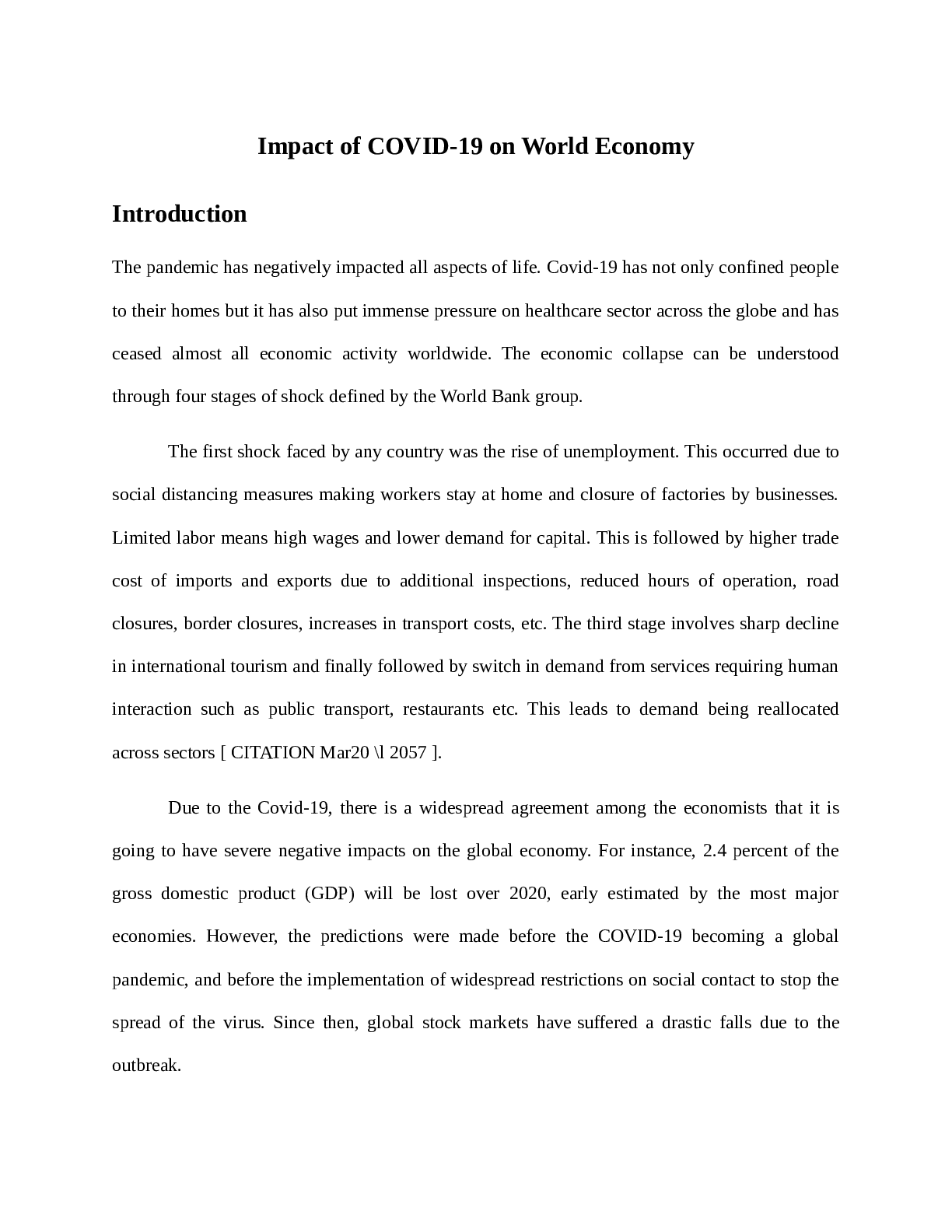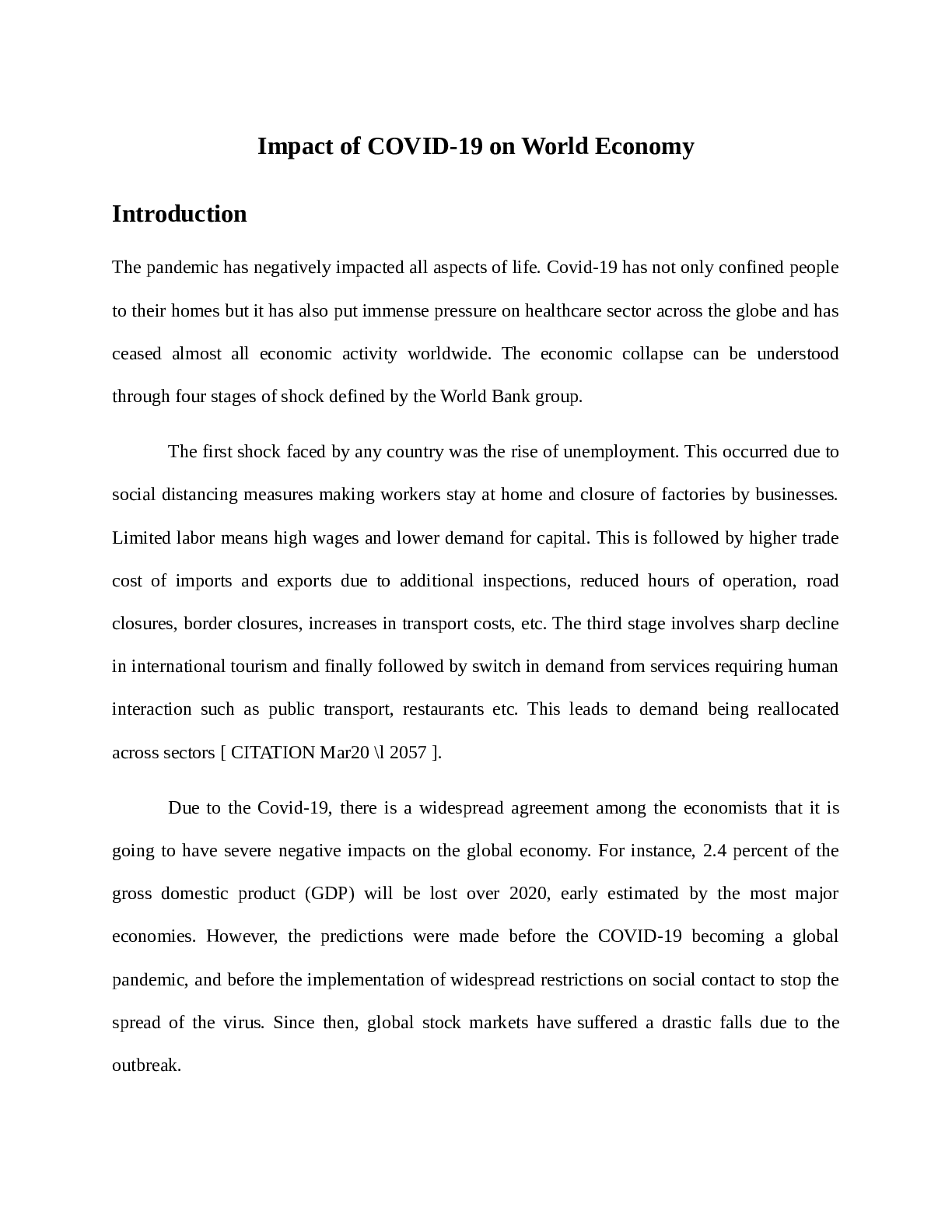Impact of COVID-19 on World Economy
Introduction
The pandemic has negatively impacted all aspects of life. Covid-19 has not only confined people
to their homes but it has also put immense pressure on healthcare sector across the globe and has
ceased almost all economic activity worldwide. The economic collapse can be understood
through four stages of shock defined by the World Bank group.
The first shock faced by any country was the rise of unemployment. This occurred due to
social distancing measures making workers stay at home and closure of factories by businesses.
Limited labor means high wages and lower demand for capital. This is followed by higher trade
cost of imports and exports due to additional inspections, reduced hours of operation, road
closures, border closures, increases in transport costs, etc. The third stage involves sharp decline
in international tourism and finally followed by switch in demand from services requiring human
interaction such as public transport, restaurants etc. This leads to demand being reallocated
across sectors [ CITATION Mar20 \l 2057 ].
Due to the Covid-19, there is a widespread agreement among the economists that it is
going to have severe negative impacts on the global economy. For instance, 2.4 percent of the
gross domestic product (GDP) will be lost over 2020, early estimated by the most major
economies. However, the predictions were made before the COVID-19 becoming a global
pandemic, and before the implementation of widespread restrictions on social contact to stop the
spread of the virus. Since then, global stock markets have suffered a drastic falls due to the
outbreak.
Based on our research, we think that the economic damage caused by the COVID-19
pandemic is largely driven by a fall in demand which means that there are less consumers to
purchase the goods and services available in the global economy. For example, it can be observe
in heavily affected industries such as travel and tourism. In order to slow the spread of the virus,
countries placed restrictions on travel. Thus, many people cannot purchase the flights for their
holidays or business trips. It is later causing the reduction in consumer demand, followed by
revenue lost by the airline company, eventually reduce the layoff staffs to further cut costs.
The same situation could be applied to other industries. For instance, when the social
events and holidays are being restricted due to the outbreak of Covid-19, it has been causing a
falling demand for oil and new cars as daily commutes, In addition, when the companies start to
cut the staff to make up for the lost revenue, it will create a downward economic spiral when
these newly unemployed workers could not afford to purchase the unaffected goods and services.
Moreover, by using retail as an example, an increase in unemployment will also compound
the reduction in sales that occurred from the closure of shop fronts. It is this dynamic that causes
the economists to contemplate whether the COVID-19 pandemic could lead to a global recession
on the scale of the Great Depression.
Literature Review
The literature on the impact of Covid-19 is vast as an article published by VOX argues that
throughout the history all global crisis has made firms reconsider their business models. This led
to firms investing on robots instead of relying on global supply chain. Firms are now
reevaluating Global Value Chains (GVC) where they relied on imported inputs and labors from
low wage countries to save cost. However, higher tariff rates and risk of non-delivery of imports
increased after the Global Crisis of 2008. This was followed by decline in interest rates which
made financing of robot adoption less costly. Germany is the leading user of robots followed by
South Korea and Japan. During COVID-19, rise in WUI will decrease supply chains which in
turn can substitute GVC with robots (Kemal Kilic, 2020).
Besides, for information, macroeconomic costs could materialize through both the supply
and demand effects. Thus, in response to an epidemic risk, both labour supply and consumption
will be reduced due to the limit social interactions among the workers. For example, Arnold et al
(2006) did examined the supply side channel in a 1918-like pandemic scenario. He was
combining an estimated loss of employee work days with the estimated productivity per worker.
As a result, they have come to a conclusion that the pandemic reduces GDP by about 2.3% in the
first year. In order to assess the demand side, the same study draws on the SARS episode of 2003
by assuming that the pandemic’s effects would be especially severe among industries whose
products required customers to congregate. In such, the overall demand side effects will reduce
the GDP by approximately 2%.
Next, the pandemics will cause a long-lasting adverse effects on the economy. For
instance, by looking on the supply side, Fan et al (2016) observe that, in the case of the 1918
influenza pandemic, the most important cost was mortality and the reduction of the labour force.
As a result, a one-time reduction in the labour force would raise up the ratio of capital to labour
while at the same time lower the rate of return to capital which in turn slowing the pace of capital
accumulation and GDP growth for many years.
Moreover, by looking at the demand side, pandemics may also persistently depress
aggregate demand. Jordà et al (2020) has studied the long-run effects of a sample of 12 major
epidemics in Europe stretching back to the 14th century. In such, they found out that the
pandemics were followed by low natural interest rates due to higher precautionary saving and
depressed investment opportunities.
Furthermore, there is also several studies of the macroeconomic effects of the SARS
epidemic in 2003. These studies are being used as a references in investigate the impact of the
Covid-19 in the current global economy. Based on the study, they found significant effects on
economies through large reductions in consumption of various goods and services as well as an
increase in business operating costs, and re-evaluation of country risks which reflected in
increased risk premiums. Besides, shocks to other economies were transmitted according to the
degree of the countries’ exposure, or susceptibility, to the disease. In fact, the global costs were
significant and not limited to direct affected countries (Lee and McKibbin, 2003). In addition,
there are also a few studies of SARS include (Chou et al., 2004) for Taiwan, (Hai et al., 2004) for
China and (Sui and Wong, 2004) for Hong Kong
Read More


